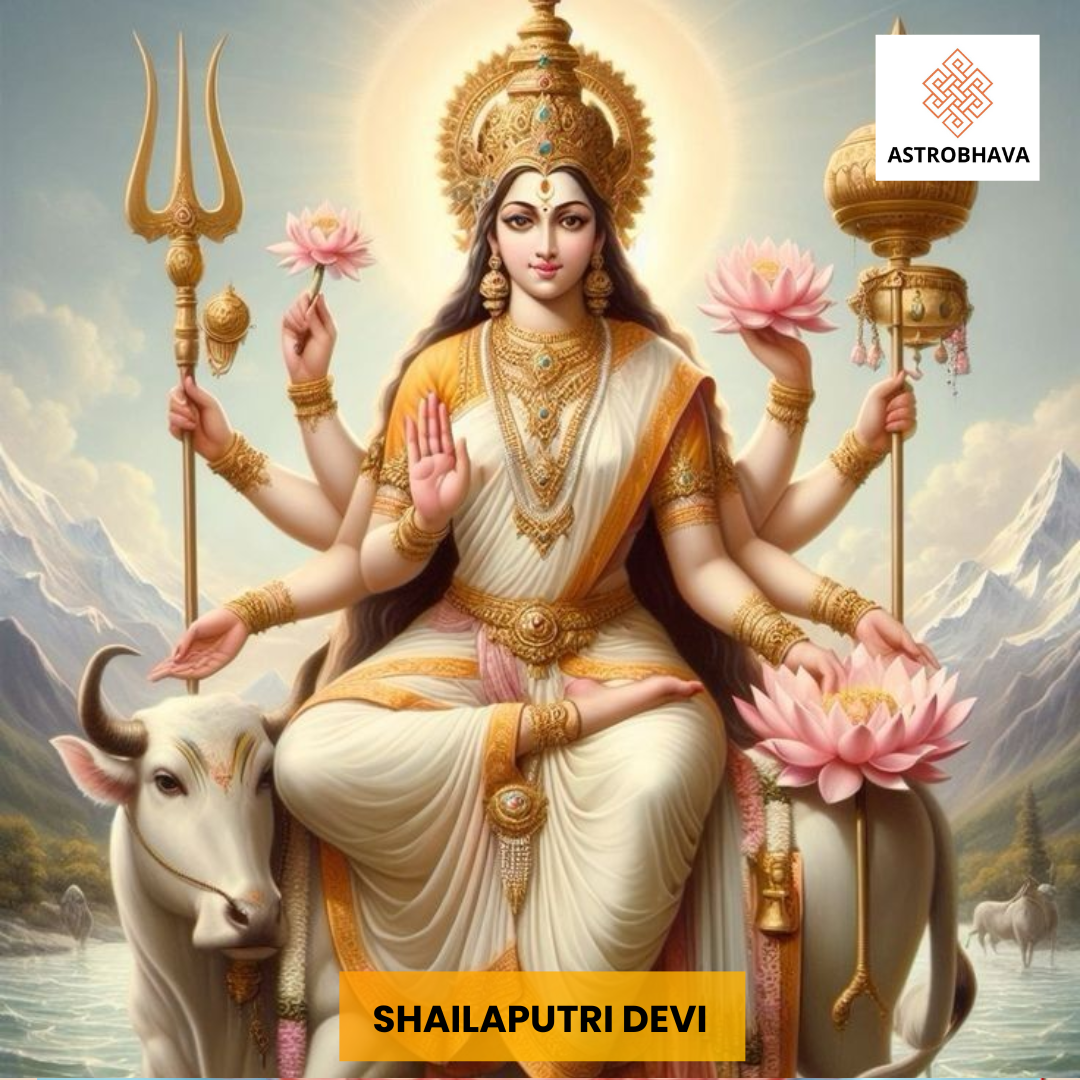Shailaputri Devi: Find Out Navratri Day 1 Mantra

Navratri is a vibrant festival that spans nine nights, each dedicated to honoring a different manifestation of Goddess Durga, who represents divine feminine energy. On the first day of Navratri, the worship of Shailaputri Devi takes place, marking the beginning of this divine celebration. Shailaputri, the first form of Goddess Durga, is worshipped for her immense strength, purity, and wisdom. This detailed guide explores who Shailaputri Devi is, her significance on Day 1 of Navratri, the mantra associated with her, and the rituals performed to seek her blessings. We will also discuss Shailaputri Puja, Shailaputri Homa, Shailaputri Japa, and address some frequently asked questions related to her worship.
Who is Shailaputri Devi?
Shailaputri translates to “Daughter of the Mountain,” reflecting her origin from the mighty Himalayas. She is the first form of Goddess Durga and represents Satvik (pure) energy, symbolizing strength, creation, and preservation. Shailaputri is depicted as a goddess riding a bull, holding a trident (symbolizing Lord Shiva’s power) in one hand and a lotus flower in the other. The bull symbolizes her control over the earthly realm, and the trident signifies her ability to remove evil forces and establish peace.
Shailaputri is the embodiment of Parvati, the consort of Lord Shiva, in her early form, and is often worshipped to eliminate negative energies and purify one’s mind, body, and soul. As the goddess of stability and security, she blesses her devotees with inner peace, wisdom, and the strength to overcome challenges.
“Experience the divine blessings of Shailaputri Devi! Join us in performing the Shailaputri Puja on Day 1 of Navratri to invoke purity, strength, and wisdom. Strengthen your foundation for the festival and seek divine protection and prosperity. Book your Shailaputri Puja today and begin your spiritual journey with blessings for success and peace.”
The Story of Shailaputri Devi
Shailaputri Devi is the first form of Goddess Durga, worshipped on the first day of Navratri. Her story is deeply rooted in Hindu mythology and is tied to the cosmic creation, the divine feminine energy, and the everlasting bond between Goddess Durga and Lord Shiva.
The Birth of Shailaputri: Daughter of the Himalayas
Shailaputri, as her name suggests, is the daughter of the Himalayas. Her story begins with the birth of Parvati, the daughter of the King of the Himalayas, Himalaya and his queen, Mena. The Himalayas were a grand mountain range, revered as the abode of Lord Shiva, the god of destruction and transformation.
When Parvati was born, she was not just any mortal child. She was divinely blessed, with a spirit that radiated purity, strength, and wisdom. Her father, King Himalaya, named her Shailaputri, which means “daughter of the mountain” (Shaila meaning “mountain” and Putri meaning “daughter”). Shailaputri was thus born into a family that was closely connected to the divine, with a purpose to fulfill a grand spiritual destiny.
Her divine birth was prophesied by the sages who foresaw her as the key to bringing balance to the cosmic world. As the daughter of the mountains, Shailaputri carried the essence of the earth and its elements, symbolizing stability, strength, and endurance.
Shailaputri’s Divine Essence and Connection to Lord Shiva
Shailaputri is not only the daughter of the Himalayas but also an incarnation of Goddess Parvati, who would later become the consort of Lord Shiva. As a child, she was known for her deep devotion, purity of heart, and commitment to righteousness.
During her youth, Shailaputri grew up under the loving and nurturing care of her parents. She was beautiful, virtuous, and graceful, admired by all who knew her. Yet, her heart longed for a deeper connection, particularly with Lord Shiva, the god of asceticism and transformation, who resided in the mountains.
Parvati’s devotion to Lord Shiva grew as she matured, and she undertook several austerities (tapasya) in order to win his heart and be united with him. But before her union with Lord Shiva, Parvati had to undergo many trials and hardships that tested her strength, patience, and resolve.
Shailaputri is considered a manifestation of Parvati in her earliest form, representing the very essence of purity and devotion. As Shailaputri, she is depicted riding a bull, symbolizing the power of stability, and carrying a trident (Trishul) in one hand, which is the weapon of Lord Shiva. In the other hand, she holds a lotus flower, symbolizing spiritual purity, divine wisdom, and the beauty of creation.
“Connect deeply with Shailaputri Devi through the sacred practice of Shailaputri Japa. Chant the divine mantra to invite strength, wisdom, and divine protection into your life. Start your Shailaputri Japa practice today and experience spiritual awakening, emotional healing, and prosperity like never before.”
The Symbolism of Shailaputri’s Form
In her form as Shailaputri, the goddess is a symbol of strength, beauty, and divine energy. She is shown as a young woman, adorned in a peaceful and pure demeanor. The trident (Trishul) she holds signifies her ability to protect her devotees from evil forces and to destroy ignorance. The bull symbolizes stability and the connection between the material world and the spiritual realm.
The lotus flower in her hand represents spiritual awakening, symbolizing the unfolding of knowledge, peace, and purity in the heart of the devotee. The bull is also a reminder of her association with Shiva, as it is often depicted as his vehicle (Vahana) in Hindu scriptures.
The Union with Lord Shiva and Her Role as Durga
Shailaputri’s devotion to Lord Shiva culminated in her penance, leading her to be united with him. Parvati, in her various forms, symbolizes the Shakti (divine feminine power) that complements Lord Shiva’s Shiva (the masculine energy). In many ways, Shailaputri marks the very beginning of that union—the energy of the mountain, the earth, and the divine power of the feminine.
After marrying Lord Shiva, Parvati became the mother of the universe, Shakti, in her many forms, one of which is Durga. The nine forms of Durga, known as the Navadurga, represent different aspects of the goddess’s divine power. Shailaputri, as the first form, represents the purest and most basic energy of creation, and she lays the foundation for the subsequent manifestations of the goddess.
Shailaputri’s Role in the Cosmic Balance
Shailaputri’s story is one of purity, strength, and devotion. She represents the beginning of the cosmic journey and serves as the base for all divine energy in the universe. As the first form of Durga, Shailaputri is invoked to help eliminate ignorance and clear obstacles in the lives of her devotees. By worshipping her on the first day of Navratri, devotees seek her blessings for inner strength, spiritual awakening, and a stable foundation for a prosperous life.
Her blessings bring peace, clarity, and balance to the mind, making her an ideal deity to worship at the start of any new journey, particularly on the first day of Navratri. Shailaputri is the embodiment of divine potential, and her worship provides a sacred opportunity to tap into this powerful energy.
Significance of Day 1 in Navratri: Worshipping Shailaputri Devi
The first day of Navratri is dedicated to Shailaputri Devi, and it sets the stage for the spiritual journey throughout the festival. Shailaputri represents the beginning of all cosmic energies and is associated with the root chakra (Muladhara), which governs stability, security, and our connection to the material world. Worshipping Shailaputri helps devotees build a strong foundation for both spiritual and material progress.
On this day, devotees pray to Shailaputri for strength, wisdom, and guidance, as her blessings are believed to help purify the mind, remove obstacles, and protect against evil influences. Devotees who worship her on Day 1 of Navratri are believed to receive divine blessings for peace, prosperity, protection, and spiritual enlightenment.
Shailaputri Devi Mantra for Navratri Day 1
The mantra dedicated to Shailaputri Devi is recited on Day 1 of Navratri to invoke her blessings. It is said to connect the devotee to the divine energy of the goddess, bringing purity, wisdom, and strength.
The Mantra:
“ॐ शैलपुत्रि महाक्रूरी महावीर्य महाशक्ति महाध्यान महाज्ञान महात्मा शिवाय नमः।”
Transliteration: “Om Shailaputri Mahakroori Mahaveerya Mahashakti Mahadhyana Mahajyana Mahatma Shivaya Namah.”
Meaning of the Mantra:
- ॐ (Om): Represents the primordial sound and the essence of the universe.
- Shailaputri: Daughter of the mountain, symbolizing purity and power.
- Mahakroori: The goddess who removes evil influences.
- Mahaveerya: The one who grants immense strength and courage.
- Mahashakti: The embodiment of infinite divine power.
- Mahadhyana: The goddess who is the object of deep meditation.
- Mahajyana: The goddess who bestows supreme wisdom.
- Mahatma: The great soul, symbolizing divine transcendence.
- Shivaya Namah: A salutation to Lord Shiva, representing the unity of Shakti and Shiva.
Benefits of Worshipping Shailaputri Devi
Shailaputri Devi is the first form of Goddess Durga, worshipped on the first day of Navratri. As the embodiment of purity, strength, and wisdom, worshipping Shailaputri on Day 1 of Navratri is believed to bring numerous spiritual, emotional, and material benefits. Her blessings can help clear obstacles, promote inner peace, and strengthen one’s connection to divine energy. Here are the key benefits of worshipping Shailaputri Devi:
1. Spiritual Purification and Awakening
One of the primary benefits of worshipping Shailaputri Devi is spiritual purification. Shailaputri is the symbol of purity, and worshipping her helps cleanse the devotee’s mind, body, and soul from negative energies, ignorance, and past karmas. By invoking her blessings, devotees can experience:
- Cleansing of the aura: Shailaputri’s energy purifies the individual’s inner self, helping to remove negative thoughts, emotions, and past wounds.
- Spiritual awakening: Shailaputri, being associated with the root chakra (Muladhara), helps awaken the devotee’s spiritual potential, allowing them to progress on their spiritual journey with greater clarity and understanding.
2. Strength and Courage to Overcome Obstacles
Shailaputri is the embodiment of strength and courage. She represents the power to overcome life’s difficulties and challenges with resilience. Worshipping Shailaputri helps devotees gain:
- Physical strength: Her divine blessings provide physical endurance, helping devotees endure hardships and stay strong in difficult situations.
- Mental fortitude: Shailaputri blesses her devotees with the mental strength to face any challenge head-on, eliminating feelings of fear and doubt.
- Emotional balance: Her blessings help in overcoming emotional obstacles, allowing devotees to maintain calm and composure in stressful or emotional circumstances.
“Invoke the powerful blessings of Bagalamukhi Devi with the sacred Bagalamukhi Puja to defeat enemies, remove negative influences, and gain victory in difficult situations. Empower yourself with divine protection and success. Book your Bagalamukhi Puja today and experience her transformative power in your life.”
3. Protection from Negative Influences and Evil Forces
Shailaputri is a powerful protector and is believed to shield her devotees from evil forces and negative energies. Worshipping her provides the following protective benefits:
- Protection from enemies: Shailaputri’s divine energy guards against external threats, including negative influences, enemies, and adversaries.
- Removal of obstacles: Her worship helps clear obstacles that prevent progress in various areas of life, including career, relationships, and personal growth.
- Shielding from evil: Shailaputri’s blessings safeguard devotees from any form of spiritual or material harm, keeping them safe from harmful influences.
4. Prosperity and Success in Life
Shailaputri is not only the goddess of purity and strength but also a bringer of prosperity. Worshipping her brings blessings that lead to success in various aspects of life:
- Financial growth: Shailaputri’s blessings are believed to bring financial stability and growth. Devotees may experience success in business ventures, career advancements, and wealth accumulation.
- Material prosperity: Devotees seeking success in material aspects of life, such as acquiring property or achieving career milestones, often worship Shailaputri to gain her blessings for prosperity.
- Abundance in health: Her blessings can promote physical well-being and energy, contributing to the overall health and vitality of her devotees.
“Unleash the powerful protection and divine blessings of Asitanga Bhairava through the sacred Asitanga Bhairava Japa. This powerful mantra helps remove fears, obstacles, and negative energies from your life. Start your Asitanga Bhairava Japa now to seek strength, victory, and spiritual enlightenment on your journey.”
5. Stability and Grounding
Shailaputri represents the root chakra, which governs stability and security. Worshipping her helps strengthen one’s foundation in both spiritual and material realms:
- Emotional stability: Shailaputri’s influence helps balance emotions and instills a sense of inner peace and emotional security, even in challenging times.
- Life balance: Her blessings promote a balanced and stable life, helping devotees maintain equilibrium between work, family, and personal life.
- Security and safety: Worshipping Shailaputri provides a sense of security, allowing devotees to feel more grounded and protected in their environment.
6. Wisdom and Knowledge
Shailaputri is also associated with wisdom and knowledge. Her divine blessings help devotees gain insight into their lives and make informed decisions. Benefits include:
- Intellectual growth: Shailaputri enhances the devotee’s ability to acquire knowledge and intellectual growth, whether for academic purposes, career advancement, or personal development.
- Better decision-making: Her blessings help devotees make wise choices, bringing clarity in all areas of life and aiding in important life decisions.
- Spiritual wisdom: By worshipping Shailaputri, devotees can gain higher spiritual understanding and develop the ability to navigate their spiritual path with greater confidence and clarity.
7. Healing and Inner Peace
Shailaputri’s worship also offers significant healing benefits for both the body and mind. Devotees experience:
- Emotional healing: Shailaputri’s divine energy helps heal emotional wounds and traumas, helping individuals recover from past hardships or sorrow.
- Physical healing: Her blessings are believed to bring relief from various physical ailments, promoting overall well-being and vitality.
- Inner peace and calm: Worshipping Shailaputri helps restore peace of mind, allowing devotees to feel centered and at peace with themselves.
8. Blessings for New Beginnings
Since Shailaputri represents the beginning of the divine cycle, worshipping her on the first day of Navratri is especially significant for those embarking on new beginnings:
- Starting new ventures: Whether it’s a new business, job, or project, worshipping Shailaputri ensures a strong foundation for success and prosperity in the new endeavor.
- Personal growth: Devotees who are seeking to transform their personal lives or make positive changes are blessed with the strength and courage to take the first steps on their path to growth.
- Spiritual renewal: Those beginning their spiritual journey will find Shailaputri’s blessings especially valuable, as her energy helps initiate a fresh start on the path of enlightenment.
“Invoke the supreme blessings of Goddess Durga with the revered Durga Puja to gain protection, peace, and prosperity. As the embodiment of strength and divine power, Durga’s blessings will empower you to overcome challenges and attain success. Book your Durga Puja today and experience the transformative power of the goddess in your life.”
9. Strengthening Family and Relationships
Shailaputri Devi is often invoked for blessings related to family harmony and relationships:
- Blessings for harmony: Worshipping Shailaputri promotes peaceful and harmonious relationships, especially within the family.
- Strengthening bonds: Her divine blessings can help resolve conflicts and strengthen relationships, promoting unity and love.
- Parental protection: Shailaputri, being the daughter of the Himalayas, symbolizes the strength and protection of the mother. Her worship can bring blessings of nurturing care and support to children and parents alike.
Rituals for Worshipping Shailaputri Devi on Day 1
The worship of Shailaputri Devi involves a series of rituals that help invoke her divine blessings and establish a strong connection with her energy. Here are the primary rituals performed on Day 1 of Navratri:
1. Shailaputri Puja:
The Shailaputri Puja is a formal ritualistic worship performed to honor the goddess. Devotees typically start the puja by setting up an altar, cleaning the home or temple space, and decorating the area with flowers and incense. The Puja is conducted in the following steps:
- Sankalpa (Resolution): Begin the worship by taking a vow or resolution to observe the rituals throughout the nine days of Navratri.
- Offer Flowers: Offer fresh white flowers to the goddess. White symbolizes purity and is the preferred offering for Shailaputri.
- Chant the Mantra: Recite the Shailaputri mantra 108 times to invoke the goddess’s divine presence and blessings.
- Prayers: Pray for peace, prosperity, wisdom, and strength. Ask for divine guidance and protection against negativity.
2. Shailaputri Homa:
Homa, or fire ritual, is an important part of the worship of Shailaputri Devi. The Shailaputri Homa involves offering ghee, grains, and other sacred items to the fire as a symbolic offering to the goddess. The process is as follows:
- Prepare a Fire Pit: Set up a fire pit and light it with sacred fire, usually using ghee or clarified butter.
- Offerings to the Fire: Offer grains, sesame seeds, and ghee into the fire while chanting mantras. The fire represents the goddess’s power to purify and transform.
- Seek Blessings: As you make the offerings, seek the goddess’s blessings for strength, health, wisdom, and protection.
“Embrace the power of the sacred Shailaputri Homa to purify your mind and remove obstacles from your path. The fire ritual invokes the goddess’s divine protection and brings peace and prosperity. Perform the Shailaputri Homa now and receive her blessings for strength, health, and success in all areas of your life.”
3. Shailaputri Japa:
The practice of Japa refers to the continuous chanting or recitation of the mantra, typically with the help of a mala (prayer beads). The Shailaputri Japa involves repeating the mantra for spiritual awakening, protection, and purification. Here’s how you can practice Shailaputri Japa:
- Use a Mala: Hold a mala of 108 beads, and chant the Shailaputri mantra once for each bead.
- Focus on Your Breath: While chanting, maintain a steady and calm breath, focusing your mind on the goddess’s divine energy.
- Complete 108 Recitations: Ideally, the Japa should be performed 108 times in one sitting to gain the full benefits of the practice.
By performing these rituals, devotees believe they can remove obstacles in their lives, gain divine protection, and strengthen their spiritual journey.
Conclusion
The worship of Shailaputri Devi on Day 1 of Navratri is a powerful way to connect with the divine feminine energy, seeking her blessings for strength, wisdom, and protection. Through the Shailaputri Puja, Shailaputri Homa, and Shailaputri Japa, devotees can purify their minds, overcome obstacles, and set the foundation for a spiritually fulfilling life.
May the divine grace of Shailaputri Devi fill your life with peace, prosperity, and spiritual enlightenment as you embark on this sacred journey of Navratri. Embrace the blessings of Shailaputri Devi, and let her strength and wisdom guide you through the festival and beyond.
Frequently Asked Questions (FAQs)
1. Why is Shailaputri worshipped on the first day of Navratri?
Shailaputri is worshipped on the first day of Navratri because she represents the primal energy that sustains and creates the universe. As the embodiment of purity and strength, her worship on the first day sets the foundation for the spiritual and material progress that follows throughout the festival.
2. How many times should I chant the Shailaputri mantra?
It is recommended to chant the Shailaputri mantra 108 times to invoke the full blessings of the goddess. You can use a mala to keep track of the repetitions.
3. What are the benefits of worshipping Shailaputri Devi?
Worshipping Shailaputri Devi helps in purifying the mind, body, and soul, removing negative influences, and bringing peace and harmony to one’s life. Devotees are blessed with strength, wisdom, protection, and spiritual awakening.
4. Can I perform Shailaputri Puja at home?
Yes, you can perform Shailaputri Puja at home, especially on the first day of Navratri. Ensure that the puja space is clean and peaceful, and perform the ritual with utmost sincerity and devotion.
5. What offerings can I make to Shailaputri Devi?
The offerings to Shailaputri Devi typically include white flowers, fruits like bananas and coconuts, and sweets like laddu. You can also offer ghee in the Shailaputri Homa.
6. Is it necessary to fast on Day 1 of Navratri?
Fasting on Day 1 of Navratri is not mandatory but is often practiced by many devotees as a form of spiritual purification. You may choose to fast according to your health and personal devotion, either by avoiding grains, consuming fruits and water, or following a partial fast.
Related posts:
No related posts.
Categories
- 10th House meaning
- 12th house astrology
- 12th House Moon meaning
- 1st house in astrology
- 2025 astrology
- 2025 festivals
- 2025 planetary movements
- 27 nakshatras
- 2nd house astrology finance
- 2nd house in astrology
- 2nd house in astrology explained
- 3rd house in astrology
- 9th house moon astrology
- Antardasha
- aries personality
- aries traits
- aries zodiac sign
- ascendant in astrology
- astro guide
- astro predictions 2025
- astro remedies
- astro tips
- Astrobhava
- Astrobhava astrology
- Astrobhava blog
- astrological effects
- astrological guidance
- astrological love compatibility
- Astrological love languages
- Astrological Remedies
- astrology
- astrology 2025
- astrology 2nd house meaning
- astrology benefits
- astrology calculator
- astrology career path
- astrology career prediction
- astrology compatibility
- astrology consultation
- astrology for business
- astrology for wealth
- astrology gemstones
- astrology guide
- Astrology Guides
- astrology houses
- astrology insights
- astrology love guide
- astrology lucky color
- astrology predictions
- astrology remedies
- astrology remedies for job
- Astrology Remedies for Wellness
- astrology rituals
- astrology solutions
- astrology soulmate signs
- astrology sun planet
- astrology tips
- auspicious yogas
- Bhagavad Gita Jayanti
- birth chart
- birth chart analysis
- birth chart reading
- birth star matching
- business astrology
- business partnership astrology
- business success astrology
- career astrology
- Career Astrology & Personal Growth
- career astrology remedies
- career by nakshatra
- career growth remedies
- career stagnation remedies
- color astrology
- communication astrology
- compatibility chart
- Cosmology
- Dasha
- dasha period calculator
- Dasha system
- divine blessings
- dosha
- dosha remedies
- dreams interpretation
- dreams meaning
- Ekadashi benefits
- Ekadashi rituals
- Ekadashi vrat
- emotional astrology
- emotional compatibility
- emotional growth astrology
- emotional healing
- entrepreneurial astrology
- Festivals & Vedic Rituals
- financial astrology
- fire sign aries
- first house meaning
- Gaja Kesari Yoga
- Gaja Kesari Yoga benefits
- gemstone astrology
- gemstone benefits
- Gita Jayanti 2025 astrology
- Gita Jayanti astrology
- hindu astrology
- Hindu calendar 2025
- Hindu fasting
- Hindu Festivals
- Hindu festivals 2025
- Hindu festivals astrology
- hindu rituals
- Homa and Fire Rituals (Yagna)
- horoscope
- horoscope analysis
- horoscope colors
- horoscope correction
- horoscope guide
- horoscope matching
- horoscope reading
- horoscope remedies
- horoscope yoga benefits
- Indian astrology
- insightful trade
- Japa
- job astrology
- Jupiter Moon yoga
- kundli matching
- kundli reading
- lagna in astrology
- Latcharchana remedies
- list of 27 nakshatras
- lord of nakshatra
- love astrology
- love horoscope
- love match astrology
- lucky color for zodiac signs
- lucky gemstones
- lunar rituals
- lunar signs
- Mahadasha
- Mahadasha Calculator
- mahadasha effects
- Mahadasha periods
- Mahadasha prediction
- Mahadasha remedies
- mahadasha results
- Mantra
- Margashirsha puja
- Margashirsha Purnima 2025
- Margashirsha rituals
- Marriage Auspicious Day
- marriage matching
- match making astrology
- Mercury planet
- Mercury Retrograde
- Mercury Retrograde dates
- Mercury Retrograde effects
- Moon and profession
- Moon astrology
- Moon astrology insights
- Moon effects in astrology
- Moon house meaning
- Moon in 10th House
- Moon in 11th House
- Moon in 12th House
- Moon in 6th House
- Moon in 6th House effects
- Moon in 6th House remedies
- Moon in 7th House
- Moon in 7th House astrology
- Moon in 7th House effects
- Moon in 7th House love
- Moon in 7th House marriage
- Moon in 7th House meaning
- Moon in 7th House remedies
- Moon in 8th House
- moon in 8th house love
- moon in 8th house marriage
- moon in 9th house
- moon in 9th house effects
- Moon in Astrology
- moon in eighth house effects
- Moon in Eleventh House meaning
- moon in ninth house meaning
- Moon in Sixth House astrology
- Moon in tenth house career
- moon meaning
- Moon placement
- Moon placement in 7th House
- nadi astrology
- Nakshatra and Mahadasha
- nakshatra astrology
- nakshatra calculator
- nakshatra career guide
- nakshatra characteristics
- Nakshatra compatibility
- nakshatra guide
- nakshatra healing
- nakshatra job compatibility
- Nakshatra Lord
- nakshatra matching for marriage
- nakshatra meaning
- Nakshatra Remedies
- nakshatra ruler
- nakshatras
- natal chart analysis
- numerology
- online astrology tool
- Panchami Festival
- partnership compatibility
- past karma
- past karma astrology
- personality in astrology
- Pilgrimage
- planetary dasha calculator
- planetary insights
- planetary mahadasha
- planetary periods
- planetary remedies
- planetary retrograde
- planetary transits 2025
- planets houses
- positivity rituals
- powerful astrology solutions
- Progency
- Puja & Rituals
- puja remedies
- Purnima 2025
- relationship astrology
- Relationships
- remove career blockages
- retrograde meaning
- rudra puja
- Rudraksha and gemstone
- sankranti 2025
- sankranti rituals
- Saphala Ekadashi 2025
- Saturn japa
- Saturn remedies
- Shani dosha
- Shani japa benefits
- Shani mantra
- Spiritual Astrology
- spiritual benefits
- spiritual growth
- spiritual healing
- Spiritual Practices and Chanting
- spiritual remedies
- Spiritual Rituals and Personal Empowerment
- spiritual significance
- Spiritual Tools & Personal Growth
- Spiritual Wellness and Protection
- Spirituality and Rituals
- Spirituality or Vedic Rituals
- star sign compatibility
- sun and zodiac signs
- Sun in Astrology
- sun in horoscope
- sun planet effects
- sun planet meaning
- sun power in astrology
- temple rituals
- twin flame astrology
- Twin Flame Astrology Signs
- twin flame compatibility
- twin flame signs
- Utpanna Ekadashi 2025
- Utpanna Ekadashi dates
- Utpanna Ekadashi rituals
- Utpanna Ekadashi significance
- Vastu Tips
- Vedic Astrology
- vedic astrology tools
- Vedic remedies
- Vivaah Panchami
- Vivaah Panchami Puja
- Vivaah Panchami Rituals
- Vivaah Panchami Significance
- vrat guide
- vrischik sankranti puja
- vrishchik rashi
- Vrishchik sankranti
- yantras
- yoga effects
- zodiac astrology
- zodiac colors meaning
- zodiac compatibility
- zodiac lucky colors
- zodiac moon traits
- zodiac relationships
- Zodiac Signs






